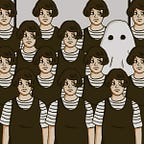Dante and Virgil — Art Criticism
Artist: William-Adolphe Bouguereau
Date: 1850
Movement: Neoclassicism, Academic Art
Medium: Oil on Canvas
Dimension: 281 x 225 cm
Location: Musee d’Orsay, Paris
Dante and Virgil is a truly breathtaking work and a prime example of classical art, with so much attention paid to the musculature of the human body. The first thing that strikes you about this painting is its unfettered ferocity, which has the effect of either turning away from it in shock or staring at it in a mesmeric state.
The setting for the work comes from Dante Alghieri’s 14th century epic poem, The Divine Comedy, which recounts Dante’s journey through Hell with his guide Virgil, the ancient Roman poet. The poem tells us that Hell is made up of nine concentric circles in the intestines of the Earth. Each of the circles contains people who have committed certain types of sin. Bouguereau’s painting depicts the two travelers arriving at the Eighth Circle of Hell. This is the Circle that is home to the deceased counterfeiters. This Circle, nicknamed Malebolge (evil pouches) is different from the other Circles because it is surrounded by a wall of dull iron-colored stone, and the valley itself is divided into ten secondary circles or pockets. The setting for Bouguereau’s work is the tenth pouch in the Eighth Circle of Hell. We see that Dante and Virgil are watching a fight between two damned souls.
So who are the two main characters portrayed in the painting as fighting, and why are they condemned to remain in this Circle of Hell, home to alchemists, counterfeiters, perjurers, and imposters? Dante Alghieri was supposed to know about the two men. One is Capocchio, a heretic and alchemist from Siena who was killed by public burning at stake in August 1293. The other is Gianni Schicchi, who is condemned to Hell for impersonating Buoso Donati and making his will very favorable to himself. After the wealthy Florentine, Buoso Donati, died in 1299, the story goes that his relatives carried out a frenetic search for his will. The will was eventually found, but to the horror of the relatives, Donati had left most of his money and possessions to the local monks. To help them find a solution and save their inheritance, the relatives then turn to the scheming but ingenious Gianni Schicchi, who has the gift of mimicry. Schicchi has no affection for the money-grabbing relatives, but nevertheless agrees to imitate Buoso Donati, as no one knows of his death other than the relatives. Schicchi successfully passes away as the deceased Donati and changes his will. The irony is that Schicchi ends up giving himself most of the belongings belonging to the dead man by modifying the will. The relatives were unable to do anything because they were involved in the fraud. This usurping of the identity of a Donati in order to falsely claim his inheritance has condemned him to the Eighth Circle of Hell.
The foreground of the painting is well lit and, like a powerful light, it almost acts as a spotlight that has been chosen by the two combatants, Schicchi and Capocchio, in the foreground.
Capocchio, the heretic and alchemist, is attacked and bitten to the throat by Gianni Schicchi, the usurper. He’s acting like a vampire. In the shadows of the background, we see Dante and Virgil standing together. Virgil is dressed in a red cloak and a hat, and Dante is dressed in gray. Virgil looks down at the warriors, but Dante has covered his mouth in horror at what he sees in front of him. But Dante’s eyes are not fixed on the fight, but on something to the right, out of the picture. So what the hell is he looking at? Maybe there are more naked writhing bodies like those we see below the winged demon.
Virgil has taken hold of Dante and wants him to move away from this horrible scene. Above them is a flying demon that we see depicted against the fiery red background of Hell. The demon has a broad smile as he sees the men below tearing each other apart. On the floor of the fighting couple, we see a man wracked in pain, a punishment for his past sins.
Now look carefully at how Bouguereau embellished the two men’s muscle structure. Look how the distortion of the bodies in their over-prepared poses has added an animal-like ferocity to the painting. I especially like the way Bouguereau exaggerated the depiction of Schicchi’s violent stretching of the skin of Capocchio, his fingernails begin to draw blood while his knee, slammed into the back of Capocchio, bends the spine of his victim.
It is a beautiful, but very disturbing, piece of art. I’m going to feature another of Bouguereau’s history paintings in my next post, a religious one that has an undeniable feeling of savagery like today’s work, which makes the audience nervously unsettled by what they see before them.
Source: Wikimedia
